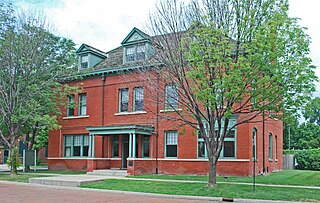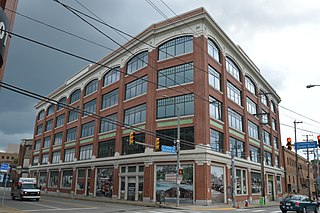
Albert Kahn was an American architect noted for his collaborations with his brother Julius Kahn in designing industrial plant complexes such as the Ford River Rouge automobile complex. Based in Detroit, he also designed skyscrapers, office buildings, and mansions in the city and suburbs, as well as many buildings at University of Michigan in Ann Arbor. Kahn has been called the "architect of Detroit" as the designer of nearly 900 buildings in the city.

Corktown is a neighborhood located in Detroit, Michigan. It is the oldest extant neighborhood in the city. The current boundaries of the district include I-75 to the north, the John C. Lodge Freeway to the east, Bagley and Porter streets to the south, and Rosa Parks Boulevard to the west. The neighborhood was listed on the National Register of Historic Places in 1978.

The Highland Park Ford Plant is a historic former Ford Motor Company factory located at 91 Manchester Street in Highland Park, Michigan. It was Ford's third factory, it was the second American Model T production facility and it was the first factory in history to assemble automobiles on a moving assembly line. Highland Park became a National Historic Landmark in 1978.

The Ford Piquette Avenue Plant is a former factory located within the Milwaukee Junction area of Detroit, Michigan, in the United States. Built in 1904, it was the second center of automobile production for the Ford Motor Company, after the Ford Mack Avenue Plant. At the Piquette Avenue Plant, the company created and first produced the Ford Model T, the car credited with initiating the mass use of automobiles in the United States. Prior to the Model T, several other car models were assembled at the factory. Early experiments using a moving assembly line to make cars were also conducted there. It was also the first factory where more than 100 cars were assembled in one day. While it was headquartered at the Piquette Avenue Plant, Ford Motor Company became the biggest U.S.-based automaker, and it would remain so until the mid-1920s. The factory was used by the company until 1910, when its car production activity was relocated to the new, larger Highland Park Ford Plant.

The Ford River Rouge complex is a Ford Motor Company automobile factory complex located in Dearborn, Michigan, along the River Rouge, upstream from its confluence with the Detroit River at Zug Island. Construction began in 1917, and when it was completed in 1928, it was the largest integrated factory in the world, surpassing Buick City, built in 1904.

Ford Motor Company Limited, trading as Ford of Britain, is a British wholly owned subsidiary of Ford Technologies Limited, itself a subsidiary of Ford International Capital LLC, which is a subsidiary of Ford Motor Company. Its business started in 1909 and has its registered office in Laindon, Essex. It adopted the name of Ford of Britain in 1960.

The Ford Richmond Plant, formally the Ford Motor Company Assembly Plant, in Richmond, California, was the largest assembly plant to be built on the West Coast and its conversion to wartime production during World War II aided the United States' war effort. The plant is part of the Rosie the Riveter/World War II Home Front National Historical Park and is listed on the National Register of Historic Places. It currently houses the National Park Service visitor center, several private businesses and the Craneway Pavilion, an event venue.

The Durant-Dort Carriage Company Office is a National Historic Landmark owned by General Motors. A late 19th-century office building located at 316 West Water Street in Flint, Michigan, it was built and occupied by GM's parent, Durant-Dort, followed by Dort Motor Car Company, until 1924.

The Omaha Ford Motor Company Assembly Plant is located at 1514-1524 Cuming Street in North Omaha, Nebraska. In its 16 years of operation, the plant employed 1,200 people and built approximately 450,000 cars and trucks. In the 1920s, it was Omaha's second-biggest shipper.

The Piquette Avenue Industrial Historic District is a historic district located along Piquette Street in Detroit, Michigan, from Woodward Avenue on the west to Hastings Street on the east. The district extends approximately one block south of Piquette to Harper, and one block north to the Grand Trunk Western Railroad Line. It was listed on the National Register of Historic Places in 2004.

The Ford Motor Company Assembly Plant at 699 Ponce de Leon Avenue in the Poncey-Highland neighborhood of Atlanta, Georgia was the headquarters of the Ford Motor Company's southeastern US operations from 1915 to 1942. As a result of good sales in Atlanta, and a desire to decentralize production, Ford established a combined assembly, sales, service and administration facility on Ponce de Leon Avenue, selling a peak of 22,000 vehicles per year. The assembly plant produced Model Ts, Model As and V-8s until 1942, when the plant was sold to the War Department and a new plant was opened in the Atlanta suburb of Hapeville.

The Lincoln Motor Company Plant was an automotive plant at Livernois, 6200 West Warren Avenue Detroit, Michigan, later known as the Detroit Edison Warren Service Center. The complex was designated a National Historic Landmark in 1978, due to its historic association with World War I Liberty engines and the Lincoln Motor Company. However, the main structures were demolished in 2003 and NHL designation was withdrawn in 2005.

The Ford Motor Company Edgewater Assembly Plant was located in Edgewater, Bergen County, New Jersey, United States. The factory began operations in 1930 and was closed in 1955, having been replaced by the Mahwah Assembly plant. The building was built in 1929 and added to the National Register of Historic Places on September 15, 1983, located at 309 River Road. The building was torn down in 2006 and replaced with a residential development.
The Ford Valve Plant is a factory building located at 235 East Main Street in Northville, Michigan. The plant was built as part of Henry Ford's vision of decentralizing manufacturing and integrating it into rural communities. It was listed on the National Register of Historic Places in 1995.

Henry Ford's Village Industries were small factories located in rural areas of Michigan. Ford developed his Village Industries in part to provide farm workers a stable source of income during the winter months.

The Ford Motor Company - Columbus Assembly Plant is a historic building in Downtown Columbus, Ohio. The Ford plant was constructed in 1914, to designs by John Graham. The plant operated until 1939. In later years, it became the Kroger Co. Columbus Bakery, operating until 2019. The building was sold in 2020, and is planned to be redeveloped into a large residential complex, announced in 2021. The building was added to the National Register of Historic Places and Columbus Register of Historic Properties in 2021.

The Ford Mack Avenue Plant, a rented wagon manufacturing shop in Detroit, Michigan, was the first facility used by the Ford Motor Company to assemble automobiles. Henry Ford began to occupy it in April 1903 in preparation for the company's incorporation, which occurred on June 16, 1903. Production of the original Ford Model A began that same month after the incorporation. Soon after, the building was expanded and a second story was added to increase production. The Model A was followed by the Model AC, which was a Model A with the larger Ford Model C engine. Most of the major car components were manufactured by outside companies, including the "running gear", which was supplied by the Dodge Brothers Company. A total of 1,708 cars were assembled at the Mack Avenue Plant. The company occupied the building until October 1904, when its manufacturing operations were moved to the Ford Piquette Avenue Plant in Detroit, where the Ford Model T would later be built.

The Ford Motor Company Brooklyn Plant is a former industrial plant once owned by the Ford Motor Company, located at 221 Mill Street in Brooklyn, Michigan. The plant was one of Ford's village industries, which were small factories located in rural areas in southern Michigan. It was listed on the National Register of Historic Places in 2017.

The Ford Motor Company Assembly Plant is a historic former automobile assembly plant in the Bloomfield neighborhood of Pittsburgh, Pennsylvania. Located along a stretch of Baum Boulevard nicknamed "Automobile Row" due to its high concentration of auto-related businesses, the plant was built in 1915 by Ford Motor Company to assemble Ford Model T cars using the company's pioneering mass production processes. It was designed by Ford's corporate architect John H. Graham, Sr. and constructed from reinforced concrete. The plant consists of an eight-story main building which contained the assembly areas and a vehicle showroom, and a six-story crane shed which was used to hoist parts unloaded from the adjacent Pennsylvania Railroad tracks to the appropriate level for assembly. Due to the steeply sloping site, the building has only five stories above grade along the street elevations.





















